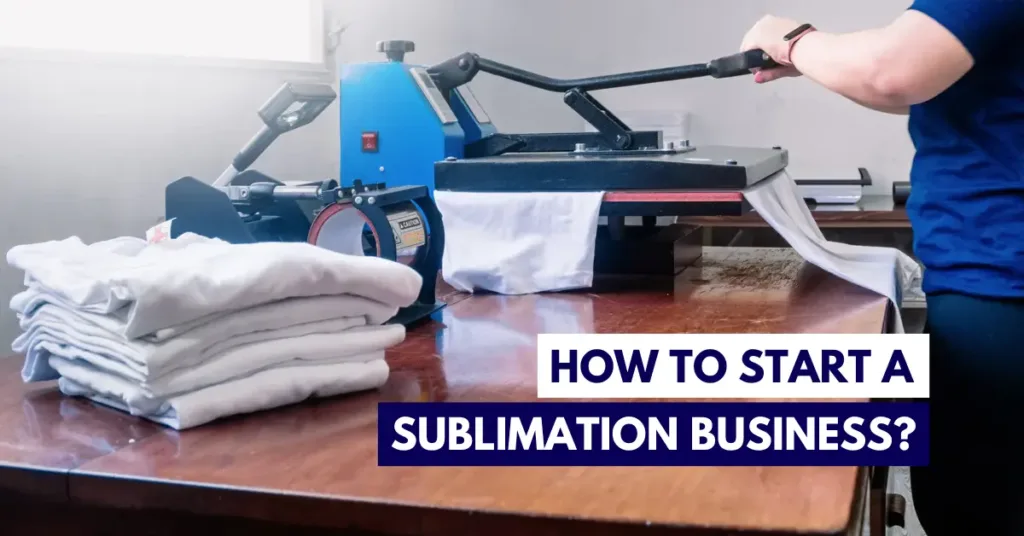The sublimation industry has been gaining much recognition recently. If you are someone who’s wondering how to start a sublimation business, then you have come to the right place. It can be daunting to step into a new business without having a clue of the direction you should take. That is why we have created this comprehensive roadmap for your ease.
The Potential of the Sublimation Industry
Sublimation printing is so much more than just a fun activity. If done right, it can become a very lucrative business. It doesn’t matter whether you want to target local clients or provide mass production to larger organizations; there is a large profit margin for you to explore in the sublimation industry.
Alternatively, you can set up your website or sell on Etsy and Amazon by making a brand for yourself. There are so many opportunities for you to avail.
From customized T-shirts and mugs to phone cases and home decor, sublimation printing covers a wide range of products. If you are creative enough with your designs, then you can expect to make approximately $20 to $40 from T-shirts, $30 to $50 from mugs, $20 to $50 from phone cases, and $15 to $100 from home decor depending on the product.
What makes this business an even bigger catch is that it doesn’t require a hefty investment to begin with. The sublimation printing market is set to increase by 10.2% every year as future projections for the industry were mapped out. If you are interested in starting a sublimation business with competitive pricing and an innovative design approach, then you could make great money from the very start.
What’s even better is the print-on-demand option that comes with sublimation printing. Businesses specializing in this are estimated to make hundreds of thousands of dollars annually.
A Step-by-Step Guide to Starting a Sublimation Business
Our guide for how to start a sublimation business begins with the fundamentals and builds on the basic principles to give you an elaborate preview of how things should work. The following steps have been created to help you start with sublimation printing from scratch.
1. Market Survey
Before you start any business, you must do a market analysis to get a better idea of how to proceed further. You want to see how organizations, small and big, are operating in the industry.
They are your competition, and you need to assess the strategies that they are using to ensure that yours is unique. Once you gauge the potential of the local and international market, you cater your approach accordingly.
You need to identify a gap in the market that your business can bridge. Many areas within the industry are oversaturated, so you will need to steer clear of them.
Depending on whether you are conducting business with small or bigger organizations, you need to find what they require and how you can provide it to them in a way other businesses can’t. When you start a sublimation business, you need to have a selling point that makes you stand out amongst the competition.
Going into business without understanding the target audience is one of the biggest mistakes you can make. You have to align your business’s goals and vision with what your target audience needs. Therefore, to better understand their needs, you have to see the sales patterns in the market, as that would give you insights about what you should and shouldn’t invest in.
2. Selecting a Profitable and Unique Niche
You are going to be starting as a small company with not a lot of recognition that most major brands have. However, there is a way to work around this disadvantage, and that is to choose the right niche for your business.
There are already many established sublimation printing brands out there. This is why when a potential client searches for custom products, these brands are likely to come at the top of the results. You won’t be able to compete with that.
Broadening up your options won’t serve your business’s purpose. Finding a narrower and more specific niche would assist you in building your brand’s reputation. If you can break down your niche into subniches, then that would be even better. How can you decide on what your niche and subniches should be? That depends on a few factors.
The first is to study the market demand, which you previously did, so you can move forward. The next is to see the profit margins and the volume of orders. You don’t want to market products that no one is willing to buy.
The overlap of these three factors is where you will find the answer for your niche. Therefore, you should work on optimizing your strategies so that all of the factors are satisfied.
3. Considering Legal Matters
No business can be made official until legal matters have been sorted out. You will have to register with local and federal government agencies so that no legal complications arise at a later stage. Before registering, it is important to recognize how you would characterize your business. It can either be characterized as a sole proprietorship, partnership, or limited liability company (LLC).
Deciding this is necessary to ensure liability protection of your choosing. LLC typically has the most liability protection, while partnership has some personal liability protection and sole proprietorship has none.
If you are just starting and are not targeting a very wide audience, then sole proprietorship is your best option. However, if you want to expand your business into a full-time career, then you can choose one from a partnership or LLC.
Once selected, you should register with the relevant agency in your country so that you can get a license to operate. This step is also important to protect the interests of your business. Visit the agency’s website and get the required information and paperwork to begin the licensing process.
They will take some time to review your application and get back to you regarding their decision. Your local business licensing office can also guide you on any other permits that you might need. This is how to start sublimation business.
4. Choosing Essential Sublimation Equipment
Even though you may not require as many resources as other businesses, some pieces of equipment are a must-have when you are starting a sublimation business.
i. Sublimation Printer
This is the first piece of equipment that you should think about getting before you can proceed with your business. This is a special printer that is required to print the sublimation ink on the sublimation blanks.
As you are just beginning you can go for a smaller model of the printer that could be somewhere between $500 to $600. However, if you want to go for more advanced models, then you can choose between Epson EcoTank ET-2720, Canon Selphy CP 1500, and Sawgrass SG 500. Based on what your needs and budget are, you can explore the three and find out which fits best with your business’s purpose.
ii. Sublimation Ink
To go along with your sublimation printer, you will require sublimation ink. Not every ink is suitable for the process, so you will need to opt for the right ink. Heat pressure is applied to the solidified ink to turn it into a gaseous state. As it doesn’t liquefy, it is referred to as a sublimation ink. Some printers come with bottles of ink to get you started. While for the others, you may need to purchase them separately.
Refillable ink cartridges are easily available, so you can buy them when you get your printer. Most of the printers come with their unique sublimation ink and are not compatible with any other. For example, Epson Ecotank printers require Epson’s sublimation ink. While Sawgrass printers require Sawgrass sublijet UHD ink. So, you have to be very careful when buying.
iii. Sublimation Paper
For sublimation purposes, only sublimation paper can be used for transfers. Other transfer papers aren’t compatible with the system and won’t show the required results. It consists of a thin layer of polymer so that when the heat is applied, it can take the impression of the ink well.
When it turns into a gas, it entirely integrates into the paper and becomes a part of it. You will have a wide range of paper sizes to choose from, so you should be very clear on the niche and types of products you have finalized.
iv. Sublimation Blanks
To facilitate the transfer of sublimation ink onto the paper, sublimation blanks are required. They are made of a variety of materials, such as ceramic, metal, and polyester.
Regardless of the material, all the blanks have a polyester coating on them, as this is what helps hold the ink when it is transferred. Sublimation blanks can take many forms, namely T-shirts and other clothing items, mugs, tote bags, phone cases, magnets, and home decor items.
v. Heat Press
The heat required for the transfer of the sublimation ink can be provided by the heat press. Based on the size of your sublimation blanks, you need to find a suitable size for the heat press. This is why when you start a sublimation business, the first step is to decide the type of products you want to create, as the choice of equipment depends on that.
For most apparel, a large surface area is required for the heat press, but for items like keychains, phone cases, and magnets, a relatively smaller surface area is needed.
For safety reasons, you should also buy heat transfer gloves. For the process to take place, the heat press operates at high temperatures, and that is why you should have some protection to ensure you don’t get injured. Also, handle the newly-imprinted blanks with the heat transfer gloves as the residual heat is still a lot to cause harm.
5. Managing the Cost of Starting a Sublimation Business
When you are exploring how to start a sublimation business, taking into account finances is one of the most crucial steps for you. Studies have shown that, generally, businesses of such nature require an initial investment of $2,450 to $3,300.
That said, this value is subject to change based on the magnitude of your operations. You should be able to get a more specific quote once you have decided on your niche and are ready to purchase your equipment.
Your total amount depends on several factors, such as the type and model of the sublimation printer or the heat press machine you are buying, the cost of sublimation ink and paper, as well as the quality of sublimation blanks.
These are just the costs of the equipment. You will probably need to spend some amount on your business license and permits. Additional costs include the price of the software that will be used to design, marketing expenses, and rent if you will be acquiring a space.
It is advised that in the start you don’t invest in too much equipment. Get your setup ready with a small and affordable printer or heat press. Once you want to expand your business, you can always get better models.
To further save your expenses, when you are sure of the sublimation blanks you want to use, buy them in bulk, as wholesale suppliers offer them at a much cheaper price. There are many design software you can get for free, so choose them over the paid alternatives. In the start, if you learn all their features, you should be able to make pretty decent designs with them.
Managing an inventory comes with additional expenses, so a more affordable option for you could be doing print-on-demand. Therefore, you will only be printing for the confirmed orders and won’t have to stress about the storage and sale of the items in inventory. This is essential information when you are learning how to start a sublimation business.
6. Marketing Strategies for Effective Growth
If you truly want to grow as a sublimation business, then you can’t do without implementing good marketing strategies. These are necessary to enhance your brand’s visibility and curate a good online presence. This is how you will reach your target audience more organically and create better engagement. Therefore, your marketing strategies should be cohesive such that when they are combined, they can drive your results.
It is a myth that you need to hire a marketing agency to be truly successful. If you do your research right, then you can make a promising plan yourself. It is recommended to make use of social media to your advantage when you are marketing. Identify which social media is good for the different types of content and use that to your advantage.
Share content that would interest your target audience and ensure that they continue to interact with it. Showcase your positive reviews in your highlights, which potential clients can access. Respond to all the feedback, especially any negative comments you may have, as you want to show them you care.
It can also be impactful to run promotions regularly. This could look like hosting contests or sales that people can’t resist. Another way to promote your brand is through partnership. Find brands that share your values and missions then collaborate with them. This is a win-win situation for both of you, and it doesn’t cost anything at all.
Make use of your social media insights to get a better idea of what is working and what isn’t. This is especially useful when you want to run ads because it will help you make informed decisions.
Ending Note
If you take the right approach to starting your sublimation business, you can expect to see favorable results in no time. Provided that these steps should be tailored to align with the unique vision and requirements of your brand, they can still act as a useful framework for you to adhere to.
Frequently Asked Questions (FAQs)
Q: Is sublimation better than screen printing?
A: Screen printing makes use of stencils to get the ink on the desired canvas. While sublimation is a chemical process that leaves a permanent impression on the sublimation blank. Screen printing is more time-consuming than sublimation, and its products don’t last as long as sublimation printing’s products.
Q: Can sublimation printing happen on a cotton shirt?
A: Yes, you can do sublimation printing on a cotton shirt. To get the best results, you should use glitter iron-on, which is a type of non-toxic polymer ink. However, you are advised not to print on darker fabrics as the images won’t come out that well.
Q: Can you troubleshoot the quality of the print?A: Yes. Even though it might be a little difficult, you can do it. If inconsistent colors are the issue, then you can troubleshoot by testing the printer settings. If ghosting is the problem, then using heat-resistant tapes could help fix it.



